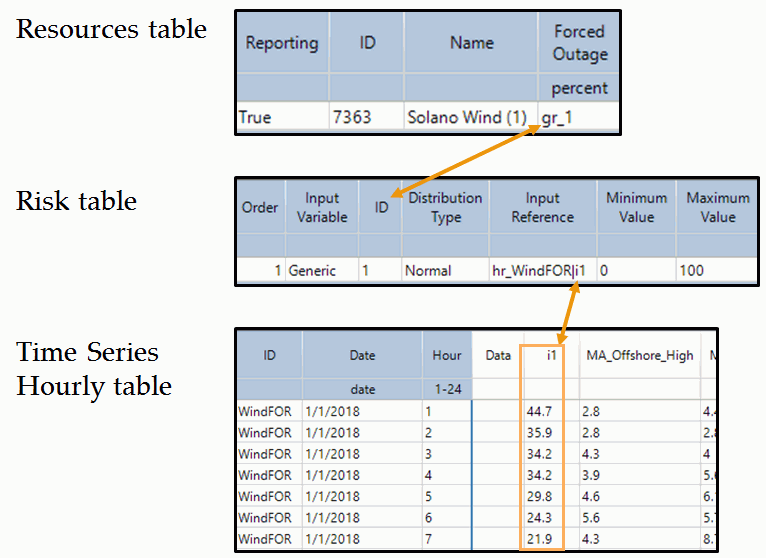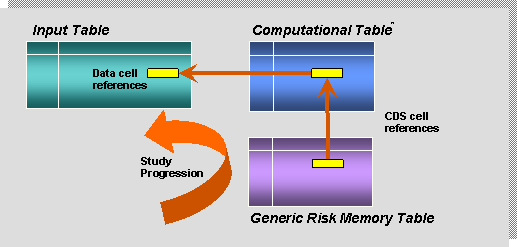Generalized Risk Methods and Modelings
Using the Generalized Risk variables provide uncertainty in study analysis by determining the appropriate range of input values (magnitude, time, correlation).
See the detailed CDS example below: Modeling Emissions Using Generic Risk, as well as the Risk Examples: Using CDS vs. Generic Logic files on the Support website > Tools & Examples page.
Aurora can calculate generic risk variables by selecting the “Generic” variable type in the Risk Input Table.

Sampling results for generic risk variables are automatically updated for each risk iteration in the Generic Risk Variables memory table.

These random numbers can then be applied to virtually any input value via two methods to allow an input field to be stochastic.
Method 1:
The preferred method is to use the gr_ reference in the desired to cell to replace (shock) the data value. For example, gr_1 would reference ID=1 in the Risk input table. The value normally entered in the data cell is the placed in the Input Reference column (Risk table) and can be a fixed value or a Time Series Reference.

Method 2:
An alternate method is via a Computational Dataset, with the “Use for input” structure, which can be referenced to replace (shock) the data.

![]() NOTE: The refresh option for the CDS table should be one of the "Pre” options (e.g., "Pre Hourly", "Pre Daily", etc.)
NOTE: The refresh option for the CDS table should be one of the "Pre” options (e.g., "Pre Hourly", "Pre Daily", etc.)
Modeling Emissions Using Generic Risk via CDS
Generic Risk Variables provide a flexible and efficient structure to determine risk for any input variable. This example shows its uses in modeling emissions, as it allows the user to:
-
Reuse rate and price records
-
Specify unique rates and prices for individual resources
-
Place no limits on emission types (SO2, NOx, CO2, Hg, particulates, etc.)
![]() NOTE: See Emissions Logic or Emissions Overview for more information specific to including emissions data in forecasts.
NOTE: See Emissions Logic or Emissions Overview for more information specific to including emissions data in forecasts.
This example will make use of the following elements:
-
Risk table - Defines distribution, time and scope of random draws
-
Unknown table - Stores base Emission Price (or other input) data and to avoid circular references
-
Memory table - Generic Risk Variables table to store random draws
-
CDS table - Adjusts input based on random draw
-
Emission Price (or other input) table - Stores reference to CDS table vs. constant
1. Input Settings in the Risk Table
Use the Risk table to setup the generic risk variables, including distribution parameters and the uncertainty in time.

2. Use an Unknown Table
Use an Unknown table type for base data. First, prepare the data in Excel, and then save the file.

Import the base data using the right-click menu on the Input Tables Window window. The data will import as an Unknown table.

3. Generic Variables Displayed in a Memory Table
During the run, the Generic Risk Variables table displays the random numbers drawn for each “generic” input variable. These values are updated for each risk iteration, and may be updated more frequently if specified in the Risk input table. These random numbers can then be applied to virtually any input value via a Computational Dataset (CDS).

4. Build a CDS Table
Use the Computational Datasets (CDS) feature to apply the generic risk variable.
Select Add Reference Columns. Select from Input Dataset for the base data and from Memory Dataset for the random variables.

Select Add Computational Column and enter the expression = base * (1 + random draw)

5. The CDS Table Computes Adjusted Input
The CDS table will populate during the run, and calculate the Emission Price adjusted with the risk variable.

6. Reference Adjusted Value In Emissions Price Table
Create a time series that points to the CDS table, then populate the Price column of the Emission Price table with the time series.

All of Aurora’s Output & Tools Available

![]() Generalized Risk
Generalized Risk
